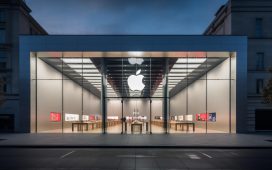In the fast-paced world of technology, even the most anticipated products can face unexpected hurdles. Apple’s latest venture into virtual reality with the Vision Pro headset initially garnered significant attention and impressive sales. However, less than a year after its debut, Apple has made the surprising decision to cease production of the Vision Pro, citing it wasn’t designed for the average consumer. Here’s a closer look at what led to this major shift and what it means for the future of VR technology.
A Groundbreaking Launch Meets Reality
When Apple unveiled the Vision Pro, it was hailed as a revolutionary step in virtual reality technology. With its sleek design and advanced features, the headset quickly became a talking point across tech forums and social media platforms. Early adopters flocked to purchase the device, with nearly 200,000 units sold within the first few weeks of its release. The excitement was palpable, reminiscent of Apple’s iconic product launches that set the bar high for innovation.
The Price Tag That Broke the Excitement
Despite the initial surge in sales, the Vision Pro’s hefty price tag soon became a sticking point. Priced at $3,999 in France and $3,500 in the U.S., the headset was a significant investment, far beyond what the average consumer was willing to spend. As a friend of mine humorously put it, “Why would I spend more than two months of rent on a VR headset?” This sentiment echoed widely, especially in regions where disposable income is limited. The high cost positioned the Vision Pro awkwardly against more affordable competitors like Meta’s Quest line, which offers robust VR experiences at a fraction of the price.
Unsold Inventory and Production Halt
As months passed, Apple found itself grappling with a surplus of unsold Vision Pro units—between 500,000 and 600,000, according to industry reports. The initial excitement had waned, and demand failed to keep pace with production. This imbalance forced Apple to make the difficult decision to halt production. While the Vision Pro was praised for its cutting-edge capabilities, the mismatch between its pricing and the target audience’s willingness to pay led to its downfall.
A Shift Toward Accessibility: A More Affordable Vision Pro
In a candid statement, Apple CEO Tim Cook acknowledged that the Vision Pro was not intended to be a mass-market product. Instead, Apple is pivoting towards developing a more affordable version of the headset. By streamlining certain features and reducing non-essential technologies, Apple aims to create a device that retains the essence of the Vision Pro’s high-end experience while making it accessible to a broader audience. Early rumors suggest that the new model could be priced around $2,300, still a significant drop but closer to competing products like Meta’s Quest 3, which launched at just $329.
Balancing Innovation and Affordability
Apple’s challenge lies in balancing cost and innovation. The Vision Pro was marketed not just as a VR device but as a standalone computer, comparable to a MacBook Pro in functionality. However, for many consumers, even the enhanced capabilities of a “virtual laptop” didn’t justify the steep price. Stephanie Smith, a tech analyst at TechInsights, notes, “Apple’s Vision Pro showcased impressive technology, but the price point alienated a large segment of potential users who could benefit from VR without the premium cost.”
Lessons Learned and Future Directions
The Vision Pro’s journey offers valuable lessons for Apple and the tech industry alike. Understanding consumer expectations and aligning product pricing with market demand are crucial for the success of innovative technologies. Despite the Vision Pro’s setback, Apple remains committed to the VR space. Tim Cook has expressed confidence that the company’s experience with the Vision Pro will pave the way for future advancements that better meet consumer needs.
Looking Ahead: The Future of VR with Apple
As Apple refines its approach to virtual reality, the focus will likely shift towards creating more affordable and user-friendly products. The company’s reputation for innovation ensures that the lessons learned from the Vision Pro will inform the development of future VR technologies. Dr. Laura Chen, a virtual reality researcher at Stanford University, believes that Apple’s commitment to quality and user experience will help them re-enter the market with a product that resonates more effectively with consumers.
Engage with Us: What’s Your Take on VR Pricing?
What do you think about the balance between technology and affordability in the VR market? Have you considered investing in a high-end VR headset, or do you prefer more budget-friendly options? Share your thoughts and experiences in the comments below! Let’s discuss how companies like Apple can innovate while keeping their products accessible to a wider audience.
Similar Posts









